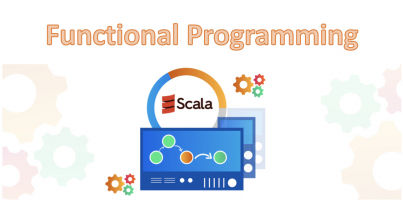Top 8 Best Books On Unit Testing
The following best books on unit testing will teach you the fundamentals of the technique, such as how to design and run tests, as well as advanced subjects ... read more...such as mocking frameworks and TDD processes.
-
The famous Pragmatic Programmers game is back! "Pragmatic Unit Testing in Java 8 With JUnit" newly revised for current software development, shows you how to confidently build and execute easily maintained unit tests in JUnit. You'll discover mnemonics to help you remember which tests to write, how to recall all of the boundary conditions, and what makes a good test. You'll discover how unit tests may save you time by keeping your system code clean, and you'll learn how to deal with material that looks too difficult to test.
"Pragmatic Unit Testing in Java 8 With JUnit" guides you through all of the essential unit testing concepts. If you've never created a unit test before, you'll see screenshots from Eclipse, IntelliJ IDEA, and NetBeans to help you get beyond the difficult portion of getting set up and started.
Once you've mastered the fundamentals, you'll understand why you should create unit tests and how to utilize JUnit efficiently. The crux of the book, however, is the collective unit testing experience of those who have been there, done that on production systems for at least 15 years: veteran author and developer Jeff Langr, who builds on the wisdom of Pragmatic Programmers Andy Hunt and Dave Thomas.
Author: Jeff Langr, Andy Hunt, Dave Thomas
Link to buy: https://bom.so/Him8O1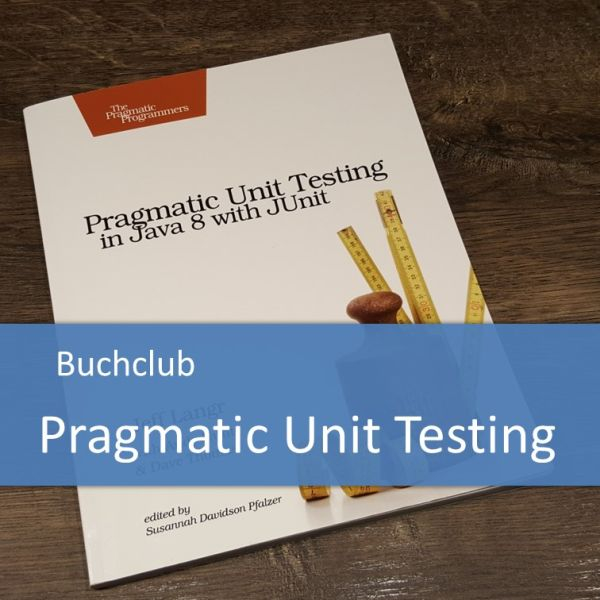
Photo: IT-Berufe-Podcast 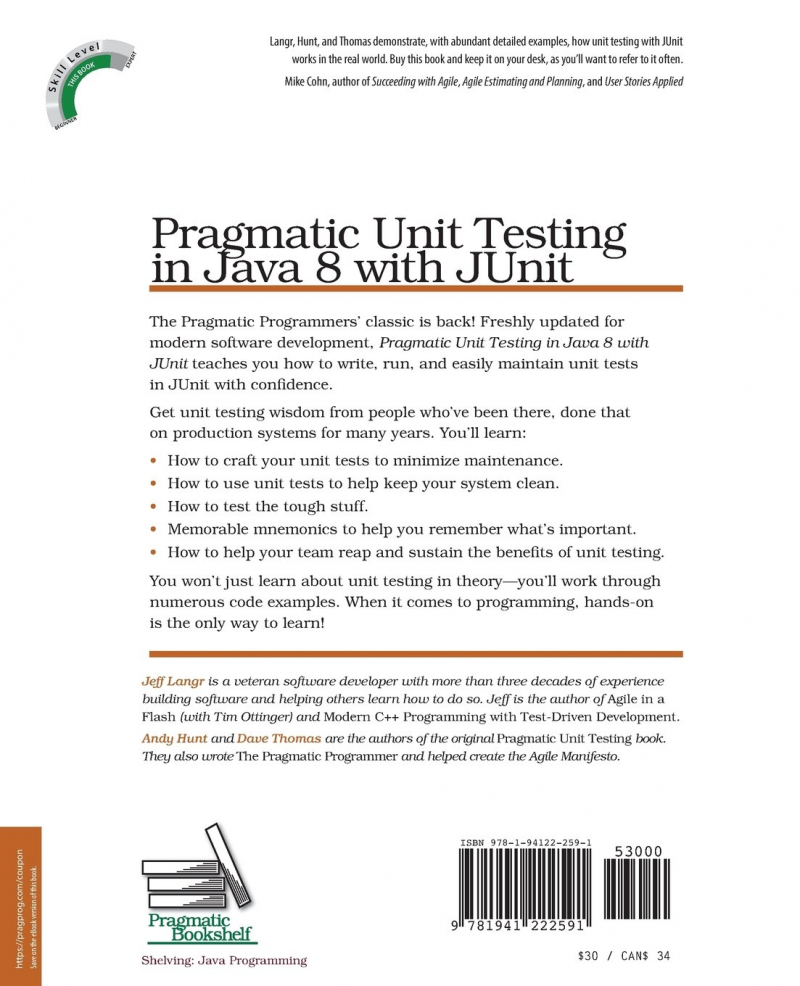
Photo: Amazon.com -
"iOS Unit Testing by Example: XCTest Tips and Techniques Using Swift" 1st Edition - With good unit tests, you may modify the design of your iOS code without fear. Using Xcode's built-in test framework XCTest and Swift, you can obtain immediate feedback on all of your code, even older code. Learn how to test any iOS code, including view controllers (UIViewControllers), which are important to iOS apps. Learn how to isolate and replace dependencies in old code that was not tested. Practice safe refactoring to enable these tests, and watch as all of your changes are tested swiftly and automatically. With perfect confidence, make even the most daring code modifications.
The deeper your navigation structure, the slower manual code and UI testing become. It might take many taps simply to get to a certain screen, let alone the real process checks. Automatic unit testing provides such quick feedback that it has the potential to modify the development norms. Bring testing to iOS development, even if the code is old. To develop unit tests in Swift for all of your code, use XCTest.
Unit tests are normally reserved for iOS model classes only. However, that technique avoids much of the code found in iOS apps, particularly UIViewControllers. Learn how to unit test these view controllers to broaden your testing options. Because solid unit tests provide the foundation for safe refactoring, you are free to make bold changes. Learn how to avoid the most common XCTest framework mistakes made by Swift programmers. To detect gaps in your test suites, use code coverage. Discover how to spot hard dependencies.
Author: Jon Reid
Link to buy: https://bom.so/BUe76w
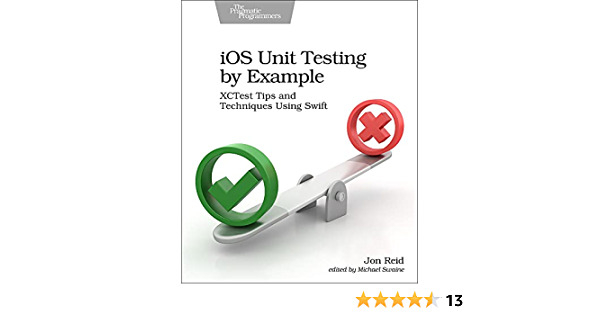
Photo: Amazon.com 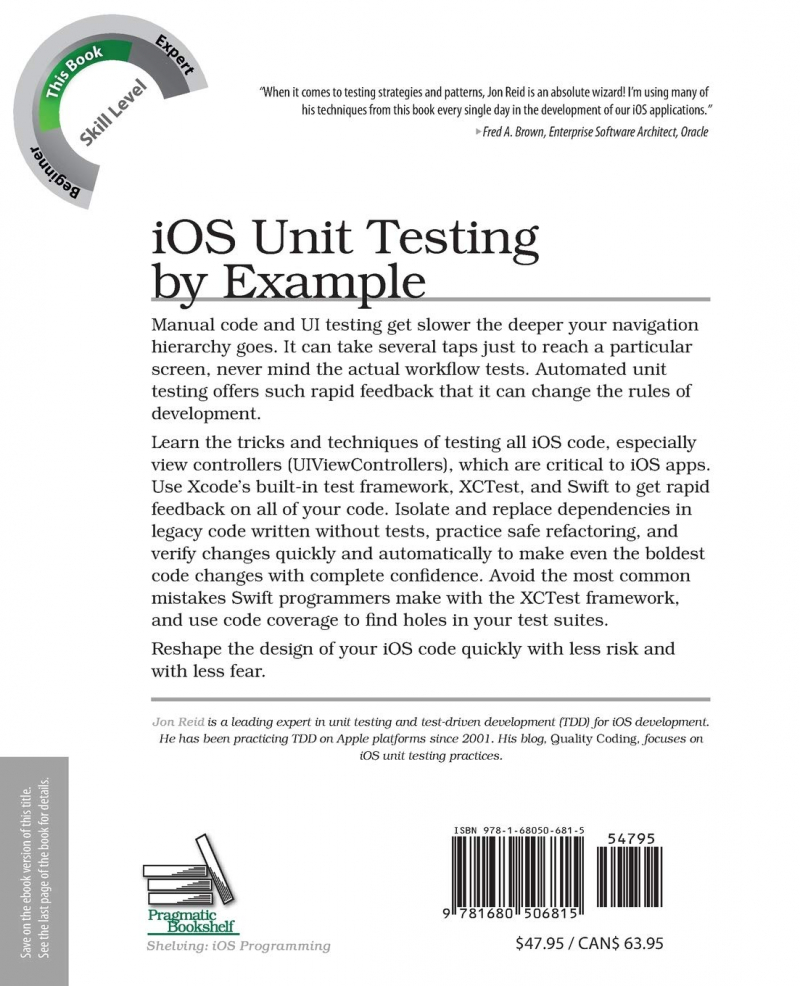
Photo: Amazon.com -
When Kent Beck and Erich Gamma published JUnit a decade ago, the Agile movement was in its infancy, "Test Driven Development" was unknown, and unit testing was only beginning to enter the ordinary developer's vernacular. Most developers now recognize the value of unit testing and rely on the more sophisticated tools that are now accessible. JUnit 4.5, which was just published, represents the state of the art in unit testing frameworks, with substantial new capabilities to improve the Java development process.
"JUnit in Action, Second Edition" is a thoroughly updated handbook on unit testing Java programs (including Java EE applications) with the JUnit framework and its extensions. This book covers approaches for testing AJAX apps, leveraging mocks to provide testing isolation, in-container testing for Java EE and database applications, and test automation.
The book, intended to assist readers take use of JUnit 4.5, includes current improvements such as new annotations that ease test authoring, enhanced exception handling, and new assertion techniques. You'll also learn how to leverage JUnit extensions to validate new application styles and frameworks like as Ajax, OSGi, and HTML-based display layers.
Various unit testing methodologies, such as how to unit test EJBs, database applications, and web applications, are explored using a sample-driven methodology. Testing methodologies utilizing publicly accessible open source frameworks and tools are also covered, as as how to unit test in isolation with Mock Objects. The book will also keep you up to date on the newest thinking in TDD, BDD, Continuous Integration, and other unit testing approaches.
Author: Petar Tahchiev, Felipe Leme, Vincent Massol, Gary Gregory
Link to buy: https://bitly.com.vn/haa7vi
Photo: Wiley India 
Photo: Googledocs -
Why aren't you conducting unit testing when you know you should? Continue reading if you're new to unit testing, find it tiresome, or simply don't feel like you're receiving enough value for your efforts.
Roy Osherove has been coding for more than 15 years and advises and instructs teams all around the world on the gentle art of unit testing and test-driven development. His blog may be found at ArtOfUnitTesting.com. Did you know, that Roy Osherove is the author of the book "The Art of Unit Testing, Second Edition" - one of the best books on unit testing.
"The Art of Unit Testing, Second Edition" walks you through the process of writing your first simple tests all the way to creating robust test sets that are manageable, readable, and trustworthy. You'll learn the fundamentals before moving on to high-value topics like mocks, stubs, and isolation, using frameworks like Moq, FakeItEasy, and Typemock Isolator. You'll look at test patterns and structure, as well as coping with old code and "untestable" code. You'll learn about integration testing, as well as strategies and tools for testing databases and other technologies, along the way.
The examples in the book employ C#, but they will be useful to anybody who uses a statically typed language like Java or C++.
Author: Roy Osherove
Link to buy: https://bom.so/yH7b5M
Photo: Biblio 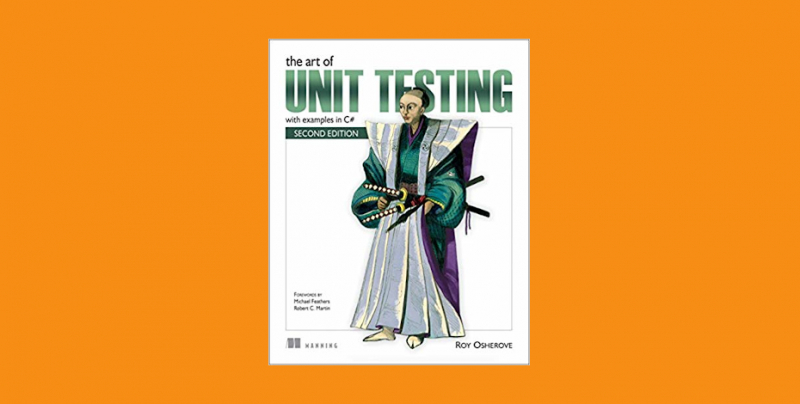
Photo: Gary Woodfine -
Agile development relies heavily on automated testing. An successful testing plan will accelerate the delivery of new features, speed up user input, and enhance quality. Creating successful automated tests, on the other hand, is a novel and unexpected task for many engineers.
"xUnit Test Patterns: Refactoring Test Code" is the authoritative book on developing automated tests using xUnit, the most widely used unit testing framework today. Gerard Meszaros, an agile coach and test automation expert, explains 68 tried-and-true principles for making tests easier to create, understand, and manage. He then demonstrates how to make them more durable, reproducible, and cost-effective.
This book is jam-packed with information and seems like three volumes in one. The first section is a comprehensive test automation lesson that covers everything from test strategy to in-depth test scripting. The second section, a collection of 18 often encountered "test smells," offers troubleshooting suggestions to assist you in determining the core cause of problems and the most suitable patterns. The third section offers full definitions of each pattern, as well as reworking techniques demonstrated by large code samples in a variety of programming languages.
Author: Gerard Meszaros
Link to buy: https://bom.so/rSpwm8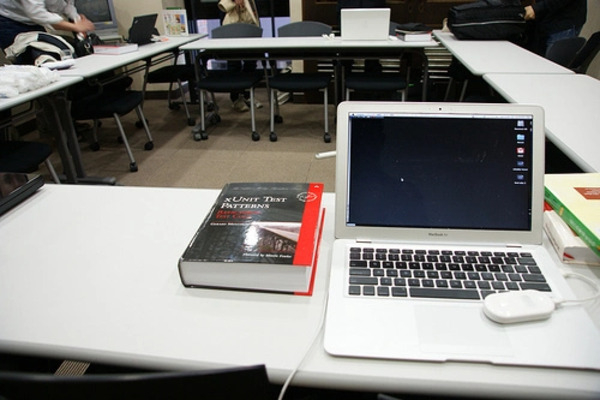
Photo: Craftsmansift 
Photo: Amazon.com -
TDD is a collection of best practices that helps developers construct more scalable software and is used to promote software robustness through the use of automated tests. "Crafting Test-Driven Software with Python", this book demonstrates how to properly utilize TDD principles in Python applications. This book is intended for Python developers who wish to learn about test-driven programming and the testing tools available in Python. This book will be valuable for Python developers who wish to design web apps and want to utilize TDD with PyTest. Python programming skills are essential.
You'll start by learning about built-in unit tests and mocks before moving on to rich frameworks like PyTest and web-based utilities like WebTest and Robot Framework, finding how Python allows you to easily embrace all current testing approaches. Following that, you'll learn how to design tests and balance them with new feature development, as well as how to establish a full test suite with PyTest. The book guides you through a hands-on approach to using TDD and related approaches, getting you up and running and more productive in no time. You'll learn about automated tests and TDD best practices, as well as the approaches and tools available in Python for designing successful and resilient applications, using step-by-step explanations of key ideas and practical examples.
By the conclusion of this Python book, you will be able to construct dependable test suites in Python to ensure the long-term robustness of your application using the Python testing and development libraries.
Author: Alessandro Molina
Link to buy: https://bom.so/94YVhE

Photo: Python Central 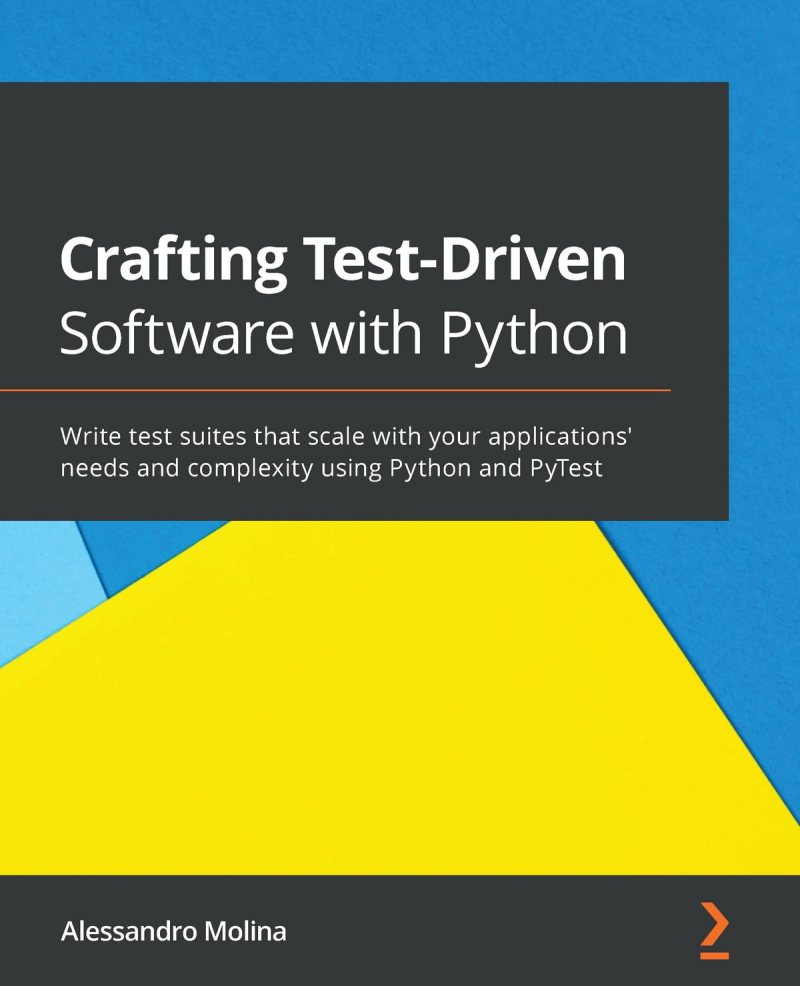
Photo: Kobo.com -
Many programmers are aware of TDD but find it difficult to apply it beyond simple examples. The book "Mastering React Test-Driven Development" demonstrates how to use Test-Driven Development to create complicated, real-world applications (TDD). It approaches TDD from the ground up, using simple Jest, and involves test-driving the integration of frameworks such as React Router, Redux, and Relay (GraphQL). This book is intended for JavaScript developers who want to apply test-driven and behavior-driven methodologies in their React applications.
Readers will obtain a thorough grasp of TDD tools and techniques as they practice methodical refactoring while building up their test framework. They'll practice client- and server-side form validation, data filtering and searching, navigation and user workflow, undo/redo, animation, LocalStorage access, WebSocket connection, and accessing GraphQL APIs.
TDD is used to modify codebases to leverage the React Router and Redux frameworks. Redux is thoroughly examined, including reducers, middleware, sagas, and related React components. Acceptance testing with Cucumber and Puppeteer is also covered in the book.
"Mastering React Test-Driven Development" is fully updated to React 16.9 and includes an extensive discussion of hooks and the 'act' test helper. Daniel Irvine is a software consultant located in the United Kingdom who wrote this book. He supports organizations in simplifying their current codebases and dev teams in increasing the quality of their software through the use of eXtreme programming (XP) methodologies. For many years, he has been mentoring developers and co-founded the Queer Code London group.
Author: Daniel Irvine
Link to buy: https://bom.so/IzrBI6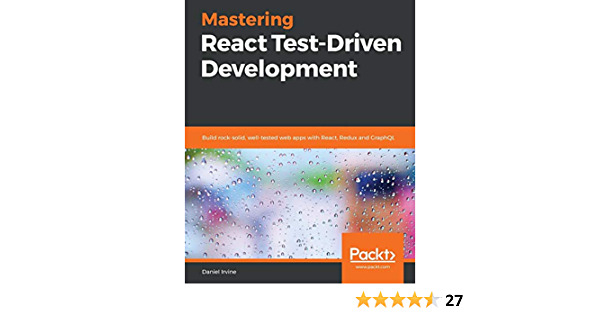
Photo: Amazon.com 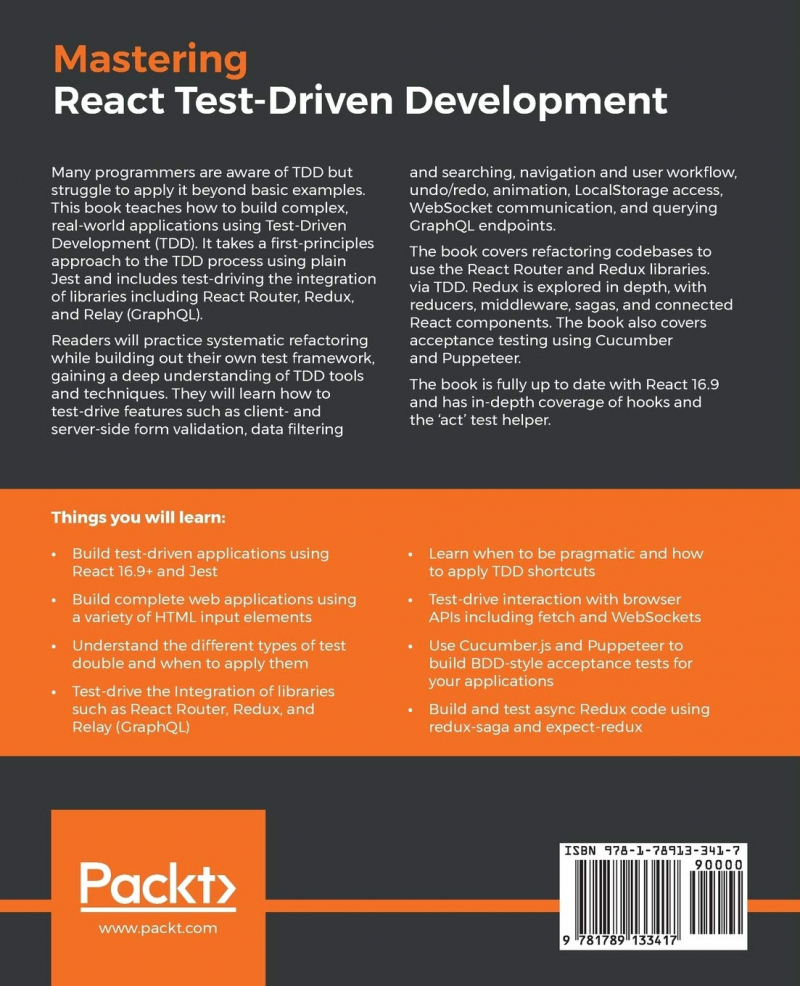
Photo: Amazon.com -
"C# and .NET Core Test Driven Development" is one of the best books on unit testing. This book teaches developers how to use the test-driven development approach to construct strong, production-ready C# 7 and .NET Core apps.
In "C# and .NET Core Test-Driven Development" you'll learn about the many stages of the TDD life cycle, the fundamentals of TDD, best practices, and anti-patterns. It will show you how to build an ASP.NET Core MVC sample application, design testable code using SOLID principles, and configure dependency injection for your sample application. Following that, you will learn about the xUnit testing framework and how to use its characteristics and assertions. In this lesson, you'll learn how to write data-driven unit tests and mock dependencies in your code. You will grasp the distinction between running and debugging tests on .NET Core on LINUX and Windows and Visual Studio. You will be able to develop a healthy continuous integration process for your sample application utilizing GitHub, TeamCity, Cake, and Microsoft VSTS as you progress.This book is for .NET developers who want to design efficient apps by using test-driven development techniques. C# programming and a working familiarity of Visual Studio are assumed. By the conclusion of this book, you will have learnt how to develop clean and resilient code using TDD, how to set up CI build steps to test and build apps, and how to package applications for NuGet deployment.
Author: Ayobami Adewole
Link to buy: https://bom.so/yIvWe9
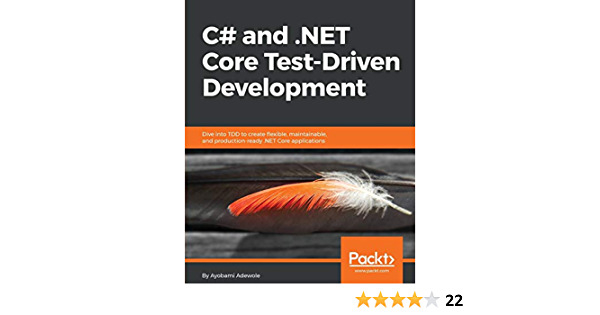
Photo: Amazon.com 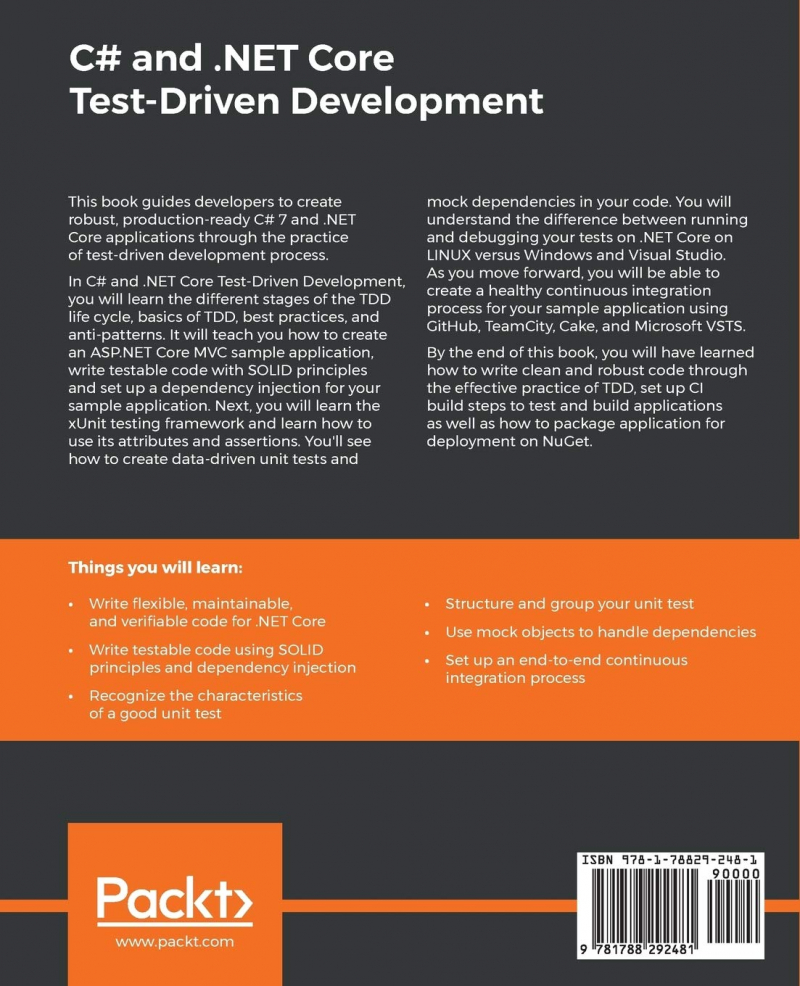
Photo: Amazon.com













